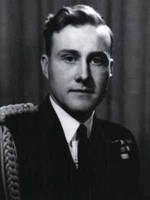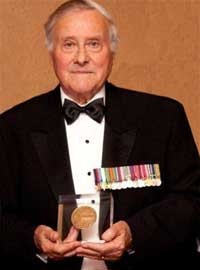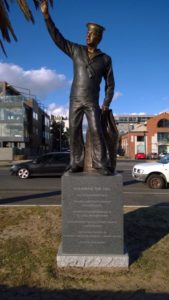By Rex Williams, President Victorian Chapter of the NHSA
As President since 2003 and active member during the period Mackenzie (Mac) Gregory was at the helm, Rex grew to love and respect Mac who he considered the grandfather he never had. Similarly, coming from a civilian background Rex attributes his passion for and now deep knowledge of naval history to his friendship with Mac Gregory.
 Mac Gregory was my close friend and colleague. Truly an Officer and a Gentleman, always anxious to help in any way he could. Generous to a fault, he happily spent hours researching families ’requests for information on a loved one’s Naval service. He was an excellent speaker and author, ever ready to promote our Navy and her people. Fiercely loyal to the concepts and objectives of our Naval Historical Society, he was a Past President of the Victoria Chapter, and at the time of his death was Vice President and Historian, offering advice and support when requested.
Mac Gregory was my close friend and colleague. Truly an Officer and a Gentleman, always anxious to help in any way he could. Generous to a fault, he happily spent hours researching families ’requests for information on a loved one’s Naval service. He was an excellent speaker and author, ever ready to promote our Navy and her people. Fiercely loyal to the concepts and objectives of our Naval Historical Society, he was a Past President of the Victoria Chapter, and at the time of his death was Vice President and Historian, offering advice and support when requested.
His’ Ahoy’ website is treasure trove featuring 28,323 articles on naval, maritime Australian historical subjects and more. My purpose in writing this treatise is to encourage you to explore his website: http://ahoy.tk-jk.net/. Mac also wrote the books; ‘WWII. The war at Sea’, ‘War in the Pacific 1941-1945 ‘and’ Fighting Sailors and Famous Sea Battles Down the Ages’.
My account of Mac’s Naval Career and some of the highlights of a life well lived cannot hope to cover the whole story and I urge you to visit his website. My sources are the website, Mac’s books and my memories of many conversations with him. Another great source is the transcript of an interview for the Australians at War Film Archive. This is available as Occasional Paper 14: on the NHSA website.
Mac was born in Geelong in February 1922. His Father was a Steward in the Navy based at Osborne House with the J class Submarines, having served previously in the British Army in WW1. His Dad generally worked for Admirals, mostly it was the first Naval Member, and Mac’s early childhood was spent in Toorak where he attended Christchurch Grammar. In later years the family moved to Coburg where he attended Coburg High.
 Cadt Midshipman Mackenzie Gregory, aged 17, on board H.M.A.S. Australia 12th of October 1939 Cadt Midshipman Mackenzie Gregory, aged 17, on board H.M.A.S. Australia 12th of October 1939 |
At age 13, Mac was successful in applying to be being accepted into RAN Naval College, then situated at Flinders’ Naval Depot, now known as HMAS Cerberus. Due to graduate in 1939, Mac’s year didn’t graduate but were instead sent to sea owing to the probability of war. An iconic photograph was published in the Sun News- pictorial in September 1939 of Cadet Midshipman Mackenzie Gregory on the foredeck of HMAS Australia looking at the guns preparing for war. Mac’s war turned out to be either at sea or on courses in England. And what a war it was! The first 9 months of the war in HMAS Australia were spent around the Australian coast and between May and July 1940 Australia was engaged in convoy duties and whilst base at Scapa Flow they were sent up to Bear Island, 900 miles from the North Pole. In September 1940 Australia was a unit of the Dakar Squadron, as part of Operation Menace to neutralise the French Fleet. She was engaged in the general bombardment of French ships and was subject to air attack by the French. In a further bombardment she sustained two hits aft and her Walrus aircraft was shot down. After that they spent time in the Mediterranean on convoy duty to Malta. Back in the UK they were based at Liverpool and in dry dock to repair damage received. It was December 1940 and Liverpool was badly bombed over three nights with a 500 lb bomb hitting the side of the dock. Part of a Middy’s job at the time was to rush around the upper deck and kick off the incendiaries that landed there over the side!
Back at sea the ship successfully rescued 9 crew members of 13 from a Sutherland Flying boat which having run out of fuel landed in the ocean in the face of an Atlantic gale! A dramatic story on its own.
Promoted Acting Sub-Lieutenant, his ship rounded the cape enroute to Aden and then into the Mediterranean. Then to Cape Town, Durban and Ceylon where he and his colleagues enjoyed 3 weeks leave. The midshipmen the returned to the UK by troop ship to undertake their Sub-Lieutenant’s courses, some of which was conducted in Brighton where they were subjected to heavy bombing. The threat of invasion was very real and at times they were called out to go and man the beaches overnight.
Back to Australia by troop ship via Halifax and the Panama Canal. Whilst home Mac got engaged to his childhood sweetheart Gladys.
Posted to HMAS Canberra and now in the war against Japan Canberra took the last troops into Singapore in February 1942, then undertook convoy work before returning to Sydney in May. Canberra was in Sydney harbour when the midget sub marines attacked on May 31st/ June 1. Mac. commented that “It was a mad night in Sydney.”
HMAS Canberra was later part of the bombardment force for Operation Watchtower, the attack on Guadalcanal. Mac mentions Major Martin Clements, the extremely courageous and able Coastwatcher on Guadalcanal who provided vital information to the Americans. Martin was a very active member of our Victoria Chapter, and he shared his experiences with us. Indeed, a very brave man.
The subsequent Battle of Savo Island commenced on August 9, 1942 and Mac has covered it in great detail on his website. It makes gripping reading!. Mac commented in his book, and I quote, “Serving as a Sub-Lieutenant RAN in HMAS Canberra, I was on her bridge as her Officer of the Watch when the Battle of Savo Island commenced on August 9,1942, we were subsequently sunk, losing eighty-four dead, with another one hundred and ten wounded.”
After survivor leave, Mac was posted to HMAS Adelaide. During this time whilst not far out of Fremantle on convoy duty they came across a merchant ship which turned out to be the German raider Ramses. In combination with a Dutch ship, the Heemscherk they sank her and whilst they were hauling in the German sailors, up paddled a dog and cat which got preferential treatment! They also rescued 10 allied merchant ship captains who had been captured by the Germans.
His next posting was to HMAS Shropshire and how he reached his ship, is a story on its own. It involved train to Brisbane and then finding a way to obtain priority on a flight to Manus Island in an American DC3. It took two days to fly there sitting on the floor amongst the mail in an unheated plane. When he reached Manus, no one knew where his ship was. He sat for 2 days in a hut in heavy rain, but when it cleared there was Shropshire about 600 yards away, anchored in the harbour. Mac was subsequently to write “I recall with affection the Officers and sailors who formed the crew of HMAS Shropshire at their peak 1280, the best ship, with the best ships company it was ever my privilege to serve in.”
In January 1945 Shropshire was in action firing full 8” gun broadsides in a softening up operation prior to landings by US Marines at Lingayen Gulf in the Philippines. The ship had been subjected to several Kamikaze attacks from Japanese aircraft, and had some close calls, but shot down several of their attackers Their port pom pom was an 8 barrelled anti-aircraft gun, each barrel capable of firing 800 rounds a minute. Leading Seaman Roy Cazaly was Captain of the gun mounting, and an incredible marksman. On January 6, Mac was Officer of the Watch on Shropshire’s bridge and squinting into the sun when he saw an aircraft diving straight for the bridge. They cleared the bridge, and flattened out on the deck of the bridge wing. There was a tremendous explosion; liquid splashed all around them. Immediate thoughts were that it was petrol which would burst into flames at any moment! With great relief Mac found it was salt water. Roy Cazaly had swung his gun around and shot the enemy plane in two. His skill saved Mac’s life and he never forgot him. Roy received The Distinguished Service Medal for his efforts! Roy was the son of ‘Up there, Cazaly’ the hero of Mike Brady’s song!
As the allies pushed north towards Japan, Shropshire took part in many landings, was subjected to the horrors of the dreadful Kamikaze attacks, and yet had not lost one man to enemy action. She was a lucky and very efficient ship, extremely well equipped to repel aircraft. Just how well she was equipped and how it occurred to be so, is a delightful story on Mac’s website. It was, however with great trepidation that they faced that next and final operation, the invasion of Japan.
Shipmates cheered and were most thankful that Harry Truman made the decision to use ‘The bomb’. Following the capitulation of Japan, Shropshire set off from Subic Bay for Tokyo Bay arriving on 31 August. The surrender was signed on September 2 on board US Missouri in Tokyo Bay.
Mac. spent the entire 1939-1945 conflict at sea or overseas, in HMA Cruisers Australia Canberra, Adelaide and Shropshire, and in the Royal Navy schools in the UK, carrying out his Sub-Lieutenant’s courses. Shropshire was chosen to take the victory contingent to England and Mac. stayed on in the UK to qualify, in Royal Navy schools as a Torpedo Anti-Submarine Officer, and upon return to Australia he was posted to the destroyer HMAS Warramunga. Some welcome shore time ensued from 1950 to 1953 when he served as Aide-de-Camp to the Governor General, Sir William Mc Kell at Government House Canberra.
In his final posting, Mac. served as Fleet Torpedo Anti-Submarine Officer on the staff of the Flag Officer Commanding the Australian Fleet, in the aircraft-carrier HMAS Vengeance. Vengeance was part of the escort which accompanied the Queen during her visit to Australia in 1954 and members of the crew formed the Queen’s guard of 120 sailors who accompanied her Majesty throughout her visit. Mac, in company with his friend LCDR (later CMDR) Hugh Jarrett and Lieutenant Stacey, were part of the guard and accompanied her Majesty all around Australia. Jarrett and Stacey were the named officers and Mac was the spare. When the Queen was visiting Canberra, Mac told Stacey to be sick and he and Hugh officiated!
In September 1954, after 20 years of service and at age 33, he resigned his commission.
 When the USS Canberra visited Melbourne, in the 60’s, Mac arranged for his son, Raymond, to be christened in the ships bell, with the CO of Canberra proudly standing as God father. In 2001, as a result of extensive lobbying by Mac and his friends, the US Navy decided to present the USS Canberra Bell to Australia as an act of friendship and to celebrate the 50th anniversary of the signing of the ANZUS treaty. It was to take place on 10 September 2001 whilst our Prime Minister, John Howard was visiting Washington DC. Both Mac and his second wife, Denise were invited to attend. Both President Bush and John Howard mentioned Mac in their speeches, and chatted to them both later. Mac and Denise were due to fly back home the next day, however this was cancelled owing to a request from John Howard to go with him to Arlington cemetery the next day in order to pay homage to the only Australian buried there. This request from the PM actually saved the lives of Mac and Denise. The flight they had been booked on was American Airlines Flight 77, the flight that was crashed into the Pentagon without any survivors on 11 September 2001.
When the USS Canberra visited Melbourne, in the 60’s, Mac arranged for his son, Raymond, to be christened in the ships bell, with the CO of Canberra proudly standing as God father. In 2001, as a result of extensive lobbying by Mac and his friends, the US Navy decided to present the USS Canberra Bell to Australia as an act of friendship and to celebrate the 50th anniversary of the signing of the ANZUS treaty. It was to take place on 10 September 2001 whilst our Prime Minister, John Howard was visiting Washington DC. Both Mac and his second wife, Denise were invited to attend. Both President Bush and John Howard mentioned Mac in their speeches, and chatted to them both later. Mac and Denise were due to fly back home the next day, however this was cancelled owing to a request from John Howard to go with him to Arlington cemetery the next day in order to pay homage to the only Australian buried there. This request from the PM actually saved the lives of Mac and Denise. The flight they had been booked on was American Airlines Flight 77, the flight that was crashed into the Pentagon without any survivors on 11 September 2001.
 Mac and Gladys raised four children in total and had a happy life together, until, sadly Gladys died. Mac found happiness again some years later when he met Denise on a cruise. He died on 27 August 2014, aged 92. His family scattered his ashes from the end of Station Pier, Port Melbourne, in accordance with his wishes.
Mac and Gladys raised four children in total and had a happy life together, until, sadly Gladys died. Mac found happiness again some years later when he met Denise on a cruise. He died on 27 August 2014, aged 92. His family scattered his ashes from the end of Station Pier, Port Melbourne, in accordance with his wishes.
A dream held by both Mac and his friend Don Boyle for a Naval Memorial at Port Melbourne came to fruition on 27 November 2015, when the Chief of Navy, Vice Admiral Tim Barrett AO CSC RAN unveiled and dedicated a bronze statue of the lone sailor, ‘Answering the Call’. The statue is situated on the foreshore at Port Melbourne, opposite Dow Street, and is across the road from the former HMAS Lonsdale. The statue commemorates the men and women of all rates and ranks of the RAN who have served from colonial times, through war and peace, and serve today and into the future. He is looking out to sea, towards the entry to Port Phillip Bay at the Rip, no doubt dreaming of adventures to come.




